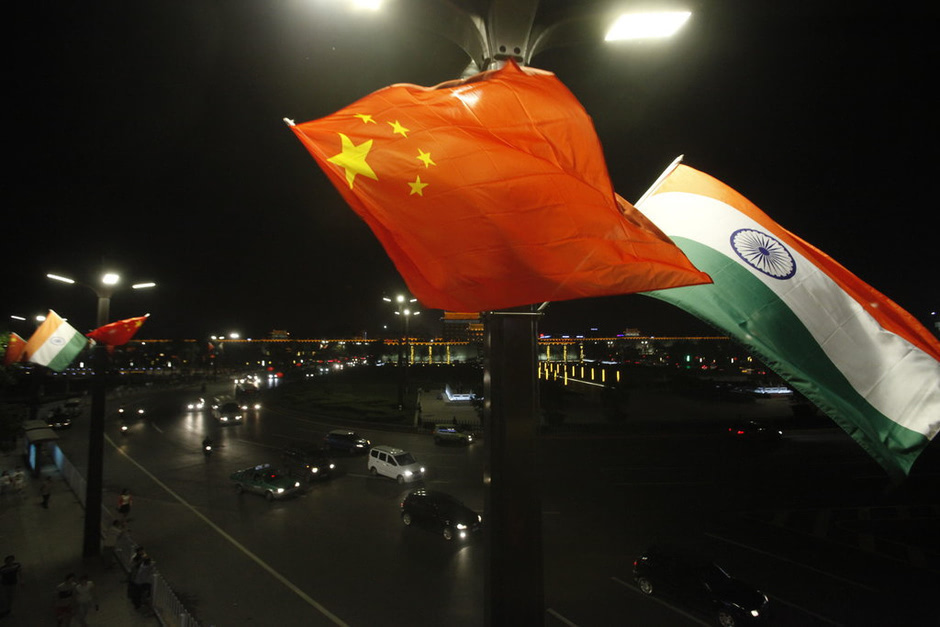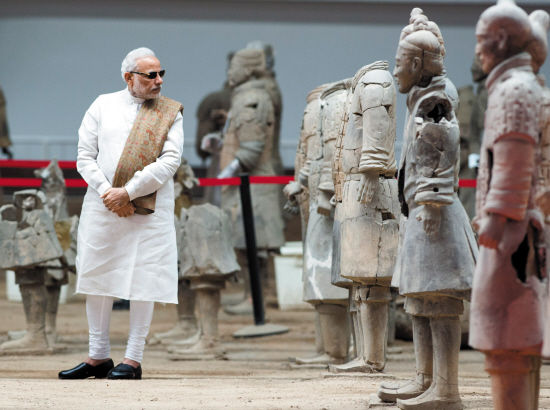Analysis of China-India relations

Indian Prime Minister Narendra Modi began his three-day visit to China in Xi’an, Shaanxi Province on May 14, 2015. Chinese and Indian national flags wave on Xi’an streets to greet PM Modi.

PM Modi visits the Qin Shi Huang Terracotta Warriors and Horses Museum in Xi’an, Shaanxi Province on May 14, 2015.
Indian Prime Minister Narendra Modi’s visit to China in May 2015 has triggered a debate about the future of relations between the two emerging Asian powers.
Ties between the two nations have been progressing in recent years through a series of high-level interactions, such as an exchange of visits by premiers in 2013 and Chinese President Xi Jinping’s visit to India in 2014.
While China and India view the diplomatic overtures in a positive light, some media and analysts in the West see bilateral relations between the two from a traditional “zero-sum” perspective. This indicates that the two sides have recognized the significance of the relationship, but it also hints at some outstanding issues.
How the two countries view historical opportunities and realistic challenges at a strategic level will have profound influence on the future direction of bilateral relations.
China-India consensus
China and India have reached a consensus on the global and strategic significance of their bilateral ties. Both sides are confident about the decisive roles they will play in the future of Asia and the whole world. The China-India Joint Statement in 2005 explicitly stated for the first time that bilateral relations are of global and strategic significance, setting the tone for future diplomatic documents.
The two nations have a shared objective to push forward the construction of a multipolar international system and to democratize international relations based on an urgent wish to forge a stable environment for economic and social development. They have complementary advantages resulting from both sides’ economic and social development and resources endowment.
Both sides regard developing their bilateral ties as a diplomatic priority. In recent years, China has firmly pursued the policy of being friendly to India. The country has established the policy of developing a long-term, stable strategic partnership with India and affirmed that no power can undermine it.
While China is setting the tone for developing relations, India has also expressed many times that it views relations with China as a diplomatic priority. They have made the further development of bilateral relations a common historical mission.
Currently, bilateral ties are more in accordance with their demand for development. The two sides have established multichannel and multifaceted mechanisms of dialogue and consultation, including strategic economic dialogues as well as defense and security consultations. The two countries are carrying out all types of dialogue and consultation mechanisms, contributing to bilateral exchanges and establishment of strategic mutual trust.
Cautious attitude to China
Despite the gradual warming of China-India ties, there are still some uncertainties.
First, the two countries have practical points of divergence with regard to borders. During President Xi ’s visit to India in 2014, both countries resolved to push forward with the settlement of all border disputes.
However, there are obstacles to progress coming from various sources, such as the public opinion and expectations, limited non-governmental exchanges, strategic extension, and overlapping interests brought about by economic development and promotion of comprehensive national strength of the two countries.
More importantly, China and India have made many measures to safeguard peace in the border regions, such as the 1993, 1996 and 2013 agreements, but these have not led to a final solution to the issue. The border question is still the main obstacle of affecting mutual trust.
Second, the Modi administration’s policy toward China indicates a tendency to separate politics from economy and trade. Currently, India has a cautious attitude toward the “One Belt and One Road” initiative proposed by China, but the fact that it has participated in financing institutions, such as the Asian Infrastructure Investment Bank (AIIB) and the BRICS Development Bank, shows it is amenable to cooperation in the field of economy and trade. However, this doesn’t mean India will eliminate its doubts about the “One Belt and One Road” initiative.
India is weak in the fields of economy and trade, but it has advantages in terms of security due to geographical and political factors. The Modi administration has strengthened relations with neighboring countries, such as Nepal, Bangladesh and Bhutan, in an effort to reestablish its dominant position in South Asia.
It also intends to balance China by pivoting its diplomacy toward countries such as the US, Japan, South Korea, Australia and even Mongolia. Project Mausam, to be launched by the Modi administration, is also widely considered a response to China’s building of the 21st Century Maritime Silk Road.
Third, India’s policy to China has shown a subtle adjustment. China is determined to establish a strategic partnership with India to work toward peace and prosperity, but India is reversing somewhat its original stance on China. From the 2003 Declaration on Principles for Relations and Comprehensive Cooperation between China and India to the 2008 A Shared Vision for the 21st Century, India has always stressed the “One China” policy in its diplomacy regarding China. However, its traditional support of the “One China” policy was no longer expressed in China-India Joint Communique in December 2010.
Cooperation greater than competition
China-India relations are undoubtedly of strategic significance to both sides, but the global significance of the relations really depends on whether they can speak with one voice.
The future of bilateral relations will be determined by whether the countries show an effort to contain each other in their respective major strategic plans or if alternatively, both countries can achieve mutual benefit through developing partnership.
Interest cooperation exceeds interest competition in the two countries’ strategic designs. China aims to establish close cooperative and developmental partnership with India. Its long-term plan has never been to contain India. The so-called “string of pearls” strategy is just a speculation with ulterior motives.
Currently, China is intensifying bilateral trade with India as well as investment in India. It has invited India to participate in the construction of “One Belt and One Road,” especially the Bangladesh-China-India-Myanmar (BCIM) Economic Corridor, hoping to achieve common development with all South Asian countries.
India is integrating into the Asia-Pacific region in all directions, striving to maintain and expand its strategic interests in this region. It is pushing forward bilateral and multilateral economic and trade cooperation with main economies in the Asia-Pacific region and actively participating in multilateral dialogue mechanisms in this region.
The economic goal in India’s policy toward China has restricted its determination to achieve strategic balance to some extent. China’s friendly policy orientation toward India has also influenced the trend of India’s policy toward China. While visiting China, Prime Minister Modi stressed in his speech that China and India have the same dream, and they will be interdependent in the future.
The core of bilateral relations is how to promote political and strategic mutual trust. Cultural exchanges, partnerships and multilevel dialogues should be important ways to establish the trust between both sides.
In the future, whether China and India can properly balance the relations between cooperation and competition, economic and political interests, bilateral and regional interests will determine the tone and extent of their relations. Cooperation and competition in bilateral constructive relations will be the norm of future relations between the two sides.
Wu Zhaoli is from the National Institute of International Strategy at the Chinese Academy of Social Sciences.
